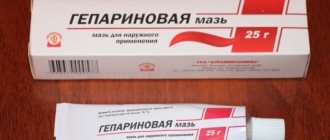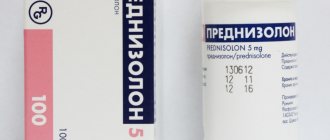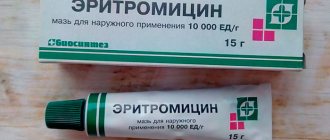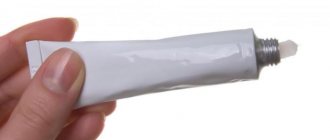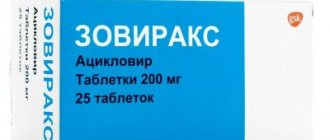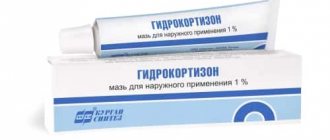List of ointments for viral conjunctivitis
With viral conjunctivitis, the eyes become very inflamed. Discharge from the inner corner of the eyes is completely absent or only slightly formed. Complex and local treatment is necessary. The doctor prescribes antiviral drops, which are supplemented with ointments in complex therapy.
Acyclovir
The main active ingredient is the sodium salt of acyclovir. After application under the lower eyelid, the active components are quickly absorbed into the mucous membrane and cornea, causing an effect. Acyclovir only acts against the herpes virus.
The drug removes pathogenic microorganisms on the surface structure of the mucous membrane of the eye, as well as in the deeper layers of the cornea.
The main advantage of the drug is the low risk of adverse reactions, which exist only in case of individual intolerance to one of the components of the drug. In this case, an allergic reaction may occur, accompanied by irritation and itching.
Florenal
A drug whose main active ingredient is fluorenonylglyoxal bisulfite. The ointment is quite viscous, as it contains petroleum jelly. Therefore, it is not washed off from the mucous membrane of the eyes for a long time.
If the pathological process has just begun and is in the acute stage, the drug is applied to the eyes 3 times a day. It is recommended to do this before going to bed so that the remaining ointment is not removed from the eyes. After the exacerbation has passed, it is recommended to reduce the dosage to 2 times a day. The course of treatment continues until symptoms are completely eliminated.
The only contraindication to the use of the product is individual intolerance to one of the components. It may manifest itself with the following symptoms:
- irritation of the eyelid;
- increased production of tear fluid;
- discomfort in the eyes (itching, pain, burning);
- feeling of a foreign object under the eyelids that is not really there.
If these symptoms appear, you should not wait for addiction. The drug is immediately discontinued.
Bonafton
The main active ingredient is bromonaphthoquinone. Bonafton is active against herpes simplex and adenovirus. The action is formed by blocking the transport of active components from the cell nucleus. The drug is used for the skin, mucous membranes of the mouth, eyes, and genitals.
Applications are carried out 3-4 times a day. If the process is not eliminated, you can increase the dosage to 6 times a day.
The drug is not recommended for use by persons with hypersensitivity to one of the components, pregnant women and lactating women. It is also not recommended to use it for minors, since no tests have been conducted for this category of patients.
Ointments for the treatment of viral conjunctivitis
For viral conjunctivitis in children, ointments are also widely used. Let's look at the action of some of them.
Florenal treatment ointment has a low content of active ingredients, so it does not irritate the mucous membrane. At the same time, it effectively destroys viruses. The ointment has almost no contraindications, but sometimes it causes itching. Ointment for viral conjunctivitis in children is used 2-3 times a day.
Oxolinic ointment is considered one of the best treatments for various types of viruses, including those affecting the organs of vision. It can be used from the age of two, but only in 0.25% concentration. The product is applied up to five times a day. The drug may cause a slight tingling sensation. It has almost no side effects and is highly effective.
Another remedy that is used for viral conjunctivitis in children is Acyclovir. The peculiarity of this medication is its rapid penetration into the cornea. In the liquid that wets the cornea, this drug forms the required concentration of the medicinal substance. Recommended for use by children over two years of age.
When the causative agent of conjunctivitis is the herpes virus or chickenpox, Zovirax ointment is effective. The product is placed behind the baby's eyelid up to five times a day. Treatment ends three days after signs of the disease disappear. Sometimes, when applying ointment for conjunctivitis, a burning sensation may be felt. The drug "Virolex" has similar properties.
An analogue of the listed drugs for bacterial conjunctivitis for children is Bonafton. In addition to the antiviral effect, this remedy relieves swelling and inflammation. Until the age of 18, ointment for viral conjunctivitis in children is used only at 0.5% or 0.25% concentration.
List of ointments for bacterial conjunctivitis
For bacterial conjunctivitis, it is most important to apply the ointment to the eyes. Drops can be used during the day, but the infection can re-spread during the night, eliminating their effect. The ointment is placed under the lower eyelid or applied in a thin layer to the inner corners of the eyes.
Tobrex
The main active ingredient is tobramycin. This is a broad-spectrum antibiotic that destroys bacteria and also prevents them from reproducing. The drug is absorbed into the tissue, therefore it is used for bacterial infections of the conjunctiva, cornea, and eyelids.
Tobrex is used 3 times a day for no more than 7 days. After this time, the bacteria develop resistance to the main active ingredient, so if the disease continues, the doctor will need to replace the medicine with an analogue with a different active ingredient.
The main advantage of the product is the possibility of its use for small children, starting from 2 months from birth.
Tetracycline ointment
The main active ingredient is tetracycline, which destroys bacteria by inhibiting their growth. Tetracycline ointment is active against most opportunistic microbes, as well as salmonella and chlamydia. The medicine can be used for children only after reaching 8 years of age.
It is recommended to place the medicinal substance under the lower eyelid or on the inner corner of the eyes 3 times a day. Adverse reactions occur quite rarely. Sometimes there may be a slight decrease in the quality of vision, which quickly passes. Allergic reactions are also possible.
Erythromycin ointment
The main active ingredient is erythromycin, which destroys gram-positive bacteria. Erythromycin ointment effectively fights the inflammatory process of an infectious nature in the eyes. It must be used 3 times a day for no more than 7 days.
With an excessively long course of therapy, patients develop a secondary infection in their eyes, which will be resistant to many antibiotics.
Eubetal
A complex product containing betamethasone, tetracycline and other active ingredients. This composition provides anti-inflammatory and antibacterial effects. That is, the drug is applicable both for bacterial infections and during allergic manifestations.
The drug is used with caution for children, as it contains a hormonal substance that can cause adverse reactions. That is why the product is used for no more than 7 days.
During therapy, the medicine destroys most pathogenic microorganisms, helps eliminate swelling, inflammation, and redness.
It is not recommended to use the drug for pregnant and lactating women, as well as for patients suffering from glaucoma.
List of ointments for allergic conjunctivitis
If the patient has an allergy that manifests itself in the eyes, he will experience severe redness, inflammation, and swelling. A feeling of burning and itching appears, due to which the child constantly scratches his eyes, this aggravates his condition. Medicinal ointments are used, which are based on a steroid substance.
Hydrocortisone ointment
The drug is based on hydrocortisone, which is a steroid. It effectively eliminates itching, redness, inflammation, and swelling. It can be used starting from 2 years, but only after prior consultation with a pediatrician.
The drug is applied to the mucous membrane up to 3 times a day. The course of treatment is selected individually for each patient. Hydrocortisone ointment can be used until complete recovery, but if adverse reactions occur, it should be immediately discontinued.
Dexa-Gentamicin
A drug based on dexamethasone and the antibacterial agent gentamicin. Due to the complex combination of an antibiotic and a steroid substance, there is an antibacterial effect and suppression of inflammation, swelling, itching, burning.
According to the instructions for use, Dexa-Gentamicin is approved only for adults. But after consultation with a pediatrician or allergist, it can be prescribed for young children if the resulting effects are significantly higher than possible side effects.
Maxidex
A medicinal ointment based on dexamethasone, which is a glucocorticosteroid. It has anti-inflammatory, desensitizing, antiallergic effects. It is prescribed for inflammatory conditions of the eyelids, conjunctiva, cornea, and iris. It can also be used to prevent inflammation after surgery.
Maxidex is placed in the eyes 2-3 times a day, depending on the doctor’s prescription. The course of treatment can be continued until symptoms are completely eliminated. The presence of side effects for children has not been identified, therefore the drug is permitted only as prescribed by an ophthalmologist or pediatrician if the effect provided exceeds the risk of side effects.
Side effects
The body of each child and adult is completely individual, and the effect of using ointment to treat eye diseases can vary significantly. There are frequent cases of side processes caused by the presence of certain chronic diseases in children or individual intolerance to individual components.
If the ointment for conjunctivitis is used longer than indicated in the instructions, this may lead to the development of resistance of certain microorganisms and viruses to the components of the drug, which threatens the recurrence of the infection.
Ointment for the treatment of eye diseases cannot be used in the following cases:
- Disorders of the kidneys and liver;
- Individual intolerance to the drug;
- Increased sensitivity;
- Pregnancy and lactation period.
The following side effects are possible:
- Dizziness;
- Development of allergic reactions;
- Nausea and vomiting;
- Increased tearing and redness of the eyes;
- Weakness;
- Local irritation;
- The occurrence of repeated infections due to the resistance of pathogenic organisms to the antibiotic due to long-term use.
In order to minimize the occurrence of negative reactions, the instructions for use of the drug must be strictly followed, especially when treating conjunctivitis and other diseases in children. There have been no reports of drug overdose at this time.
- We recommend reading: how to cure red eyes in a child
Important instructions for those who wear contact lenses! If inflammation or infection occurs, stop wearing it for a while. If the disease does not progress, lenses can be worn for a short time. If you notice that visual acuity has decreased or there is clouding or redness, consult a doctor immediately! Delay is fraught with serious illness. These recommendations apply to both adults and children. If a child complains of discomfort after applying the ointment, his eyes water and look red, this is also a reason to contact a medical facility.
How to properly put ointment in a child's eyes
If the child completely refuses to put ointment under the lower eyelid, you can spread it on the inner corner of the eyes before bed. If it is possible to apply ointment under the lower eyelid, the procedure is carried out in several stages:
- thorough hand washing with bactericidal soap;
- if a child experiences the formation of crusts or pus in the eyes, they are first removed with an antiseptic solution, for example, Furacilin;
- the lower eyelid is pushed back;
- the ointment is applied in a thin strip along the length of the entire eyelid, while touching the bottle to the mucous membrane of the eyes is prohibited;
- the child closes his eyes, after which he needs to lie down for 30 minutes, it is better if his parents put him to bed.
It is possible that drug residues may be released from the inner corner of the eyes. They can be lightly blotted with a cotton pad. It is not recommended to completely wash off the product, as pressing may remove all the product from the eyelid.
Doctors often advise the use of eye ointments for various diseases. With the help of a viscous component, for example, Vaseline, the drug will remain on the mucous membrane for a long time. Drops, unlike ointments, are quickly removed from the affected area, so the effect is less observed.
